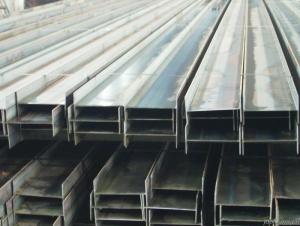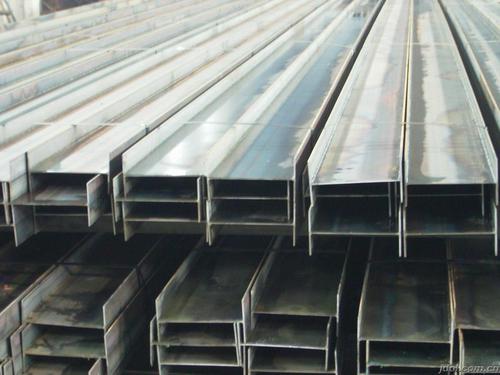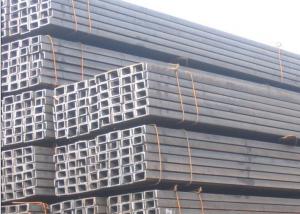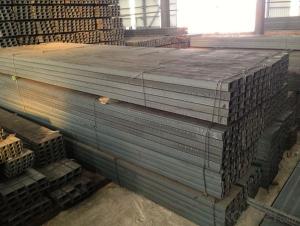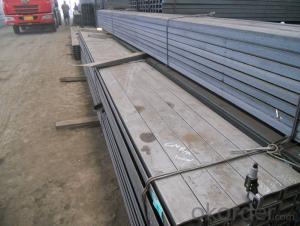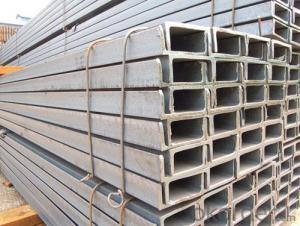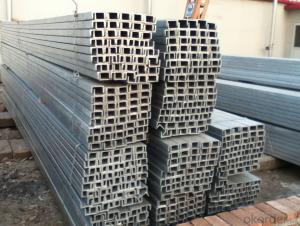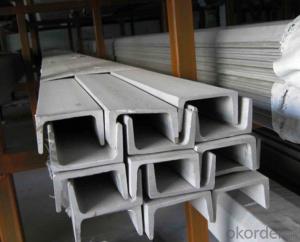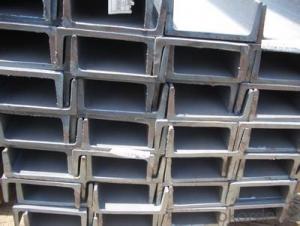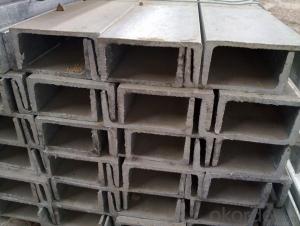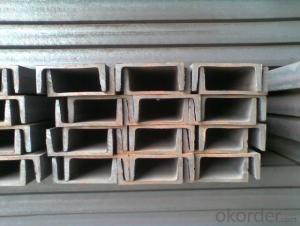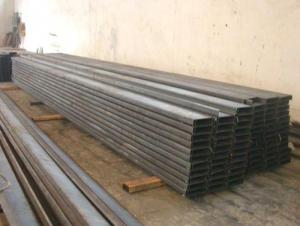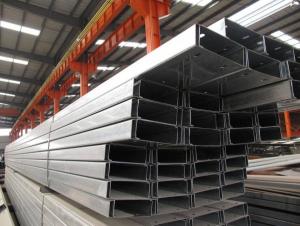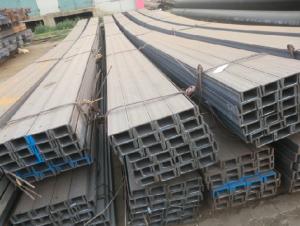CHANNEL ASTM A36 50MM-300MM OR JIS U CHANNEL
- Loading Port:
- China Main Port
- Payment Terms:
- TT or LC
- Min Order Qty:
- -
- Supply Capability:
- -
OKorder Service Pledge
OKorder Financial Service
You Might Also Like
Product Description:
OKorder is offering high quality CHANNEL ASTM A36 50MM-300MM OR JIS U CHANNELat great prices with worldwide shipping. Our supplier is a world-class manufacturer of steel, with our products utilized the world over. OKorder annually supplies products to European, North American and Asian markets. We provide quotations within 24 hours of receiving an inquiry and guarantee competitive prices.
Product Applications:
1.The JIS U Channel Steel can be devided into two kinds, namely common channel steel and light channel steel. The sizes of hot rolled common channel steel range from 5# to 40#. Meanwhile, the channel steel can be divided into cold forming sectional equal channel steel, cold forming sectional unequal channel steel, cold forming inner edge channel steel and outer edge channel steel.
2.The JIS u channel steel is usually used for arch-itechtural structure, and they could be welded in order to support or hang a vari-ety of facilities. They are also usually used in combination with I beam. The channel steel with sizes under 14# is usually applied to construction engineering, as purline, while the channel steel with sizes above 16# is more likely to be used in building vehicle chassis structure and mechanical structure. Furthermore, the channel steel in sizes above 30# are target at building bridge structure, as tension bar.
3.In a word, the channel steel must possess perfect welding property, riveting property and mechanical property and so on.
Product Advantages:
OKorder's CHANNEL ASTM A36 50MM-300MM OR JIS U CHANNELare durable, strong, and resist corrosion.
Main Product Features:
· Premium quality
· Prompt delivery & seaworthy packing (30 days after receiving deposit)
· Corrosion resistance
· Can be recycled and reused
· Mill test certification
· Professional Service
· Competitive pricing
Product Specifications:
Manufacture: Hot rolled
Grade: Q195 – 235
Certificates: ISO, SGS, BV, CIQ
Length: 6m – 12m, as per customer request
Packaging: Export packing, nude packing, bundled
Original Place | Tangshan, China | Brand Name | UINDA |
Standard | JIS G3192 : 1990 | ||
Material Grade | SS490 | ||
Sizes | 50mm to 200mm | ||
Sales Volume/Year | 3000MT | ||
Destination Area | Middle East, Africa, Southeast Asia | ||
2. The sections in details are as followings in the table-1
JIS U CHANNEL | Standard | Sectional | Dimension |
| Mass: |
| (mm) | (mm) | (mm) | (mm) |
|
50x25 | 50 | 25 | 3.0 | 6.00 | 2.37 |
75X40 | 75 | 40 | 3.8 | 7.00 | 5.30 |
75X40 | 75 | 40 | 4.0 | 7.00 | 5.60 |
75X40 | 75 | 40 | 4.5 | 7.00 | 5.85 |
75X40 | 75 | 40 | 5.0 | 7.00 | 6.92 |
|
|
|
|
|
|
100X50 | 100 | 50 | 3.8 | 6.00 | 7.30 |
100X50 | 100 | 50 | 4.2 | 6.00 | 8.03 |
100X50 | 100 | 50 | 4.5 | 7.50 | 8.97 |
100X50 | 100 | 50 | 5.0 | 7.50 | 9.36 |
|
|
|
|
|
|
125X65 | 125 | 65 | 5.2 | 6.80 | 11.66 |
125X65 | 125 | 65 | 5.3 | 6.80 | 12.17 |
125X65 | 125 | 65 | 5.5 | 8.00 | 12.91 |
125X65 | 125 | 65 | 6.0 | 8.00 | 13.40 |
|
|
|
|
|
|
150x75 | 150 | 75 | 5.5 | 7.30 | 14.66 |
150x75 | 150 | 75 | 5.7 | 10.00 | 16.71 |
150x75 | 150 | 75 | 6.0 | 10.00 | 17.90 |
150x75 | 150 | 75 | 6.5 | 10.00 | 18.60 |
150x75 | 150 | 75 | 6.5 | 10.00 | 24.00 |
|
|
|
|
|
|
200X80 | 200 | 80 | 7.5 | 11.00 | 24.60 |
3. The mechanical property of JIS U Channel Steel in the table-2:
Grade | Yield Strength,N/mm² | Extension Strength N/mm² | |||
Thickness of Steel,mm | |||||
≦16 | >16-≦40 | >40-≦100 | >100 | ||
SS490 | ≧285 | ≧275 | ≧255 | ≧245 | 490-610 |
4. The chemical composition of JIS U Channel Steel as per SS490 in the table-3
Grade | Element(%) | |||
C | Mn | P | S | |
SS490 | - | - | ≦0.050 | ≦0.050 |
FAQ:
Q1 What makes stainless steel stainless?
A1 Stainless steel must contain at least 10.5 % chromium. It is this element that reacts with the oxygen in the air to form a complex chrome-oxide surface layer that is invisible but strong enough to prevent further oxygen from "staining" (rusting) the surface. Higher levels of chromium and the addition of other alloying elements such as nickel and molybdenum enhance this surface layer and improve the corrosion resistance of the stainless material.
Q2 What makes stainless steel stainless?
A2 Stainless steel must contain at least 10.5 % chromium. It is this element that reacts with the oxygen in the air to form a complex chrome-oxide surface layer that is invisible but strong enough to prevent further oxygen from "staining" (rusting) the surface. Higher levels of chromium and the addition of other alloying elements such as nickel and molybdenum enhance this surface layer and improve the corrosion resistance of the stainless material.
Q3: The products are invoicing on theoritical weight or on actual weight?
A3: We can do it in both manners, according to the customers' request.
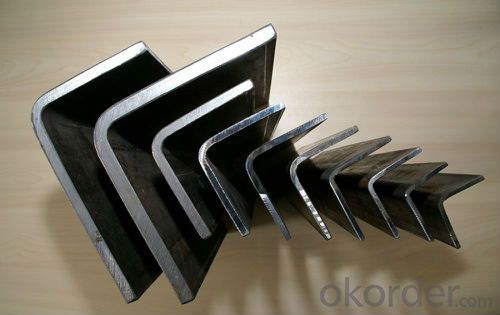
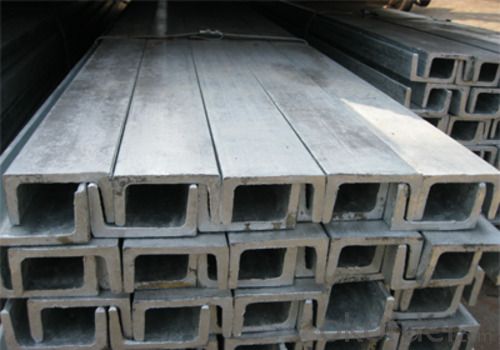
- Q: Can steel channels be used for pipe supports?
- Certainly, pipe supports can benefit greatly from the effective utilization of steel channels. With their high strength and durability, steel channels possess the perfect qualities to offer robust support to pipes. The ability to easily fabricate them into desired lengths and shapes further enhances their suitability for creating tailor-made pipe support systems. Moreover, steel channels boast exceptional load-bearing capacity, guaranteeing the stability and safety of the pipes. Their resistance to corrosion becomes particularly vital in environments featuring moisture or harsh chemicals, where the protection of pipes is paramount. Ultimately, steel channels emerge as a dependable and economically viable option for pipe supports.
- Q: How do steel channels contribute to the overall cost-effectiveness of a wastewater treatment plant?
- There are numerous ways in which steel channels enhance the cost-effectiveness of a wastewater treatment plant. To begin with, steel channels possess exceptional durability and a long lifespan. Consequently, they necessitate minimal maintenance and replacement, resulting in reduced operating costs. By minimizing the need for regular repairs or replacements, the overall maintenance expenses of the plant are lowered. Moreover, steel channels provide outstanding structural strength and stability. They can endure heavy loads and pressures, thereby ensuring the integrity of the wastewater treatment system. This eliminates the requirement for additional reinforcements or supports, lowering construction costs and simplifying the overall design of the plant. Additionally, steel channels offer a high degree of design and installation flexibility. They can be easily customized to meet specific project requirements, enabling efficient utilization of space and resources. This adaptability aids in optimizing the layout of the treatment plant, maximizing its operational efficiency, and reducing construction costs. Furthermore, steel channels exhibit resistance to corrosion and chemical degradation, which is imperative in a wastewater treatment environment. This resistance diminishes the need for frequent replacement or repairs due to corrosion-related issues, resulting in long-term cost savings. Lastly, steel channels are often manufactured using recycled materials, rendering them an environmentally friendly option. By employing recycled steel, the overall production costs are reduced, leading to lower material expenses for the wastewater treatment plant. This not only contributes to the cost-effectiveness of the plant but also promotes sustainability and reduces the carbon footprint associated with its construction. In conclusion, the durability, structural strength, flexibility, corrosion resistance, and use of recycled materials of steel channels all contribute to the overall cost-effectiveness of a wastewater treatment plant. These factors aid in minimizing maintenance and replacement costs, optimizing design and construction, maximizing operational efficiency, and promoting environmental sustainability.
- Q: How much is the weight per square metre of channel 10?!
- 10 channel steel, the national standard of rice weight is 10.007, but the production must be worse, the general national standard of about 5%, but also under the difference of more than 15%!
- Q: Do steel channels have any specific electrical conductivity properties?
- No, steel channels do not have any specific electrical conductivity properties as they are primarily used for structural purposes rather than conducting electricity.
- Q: What does "channel weight" mean?
- The theoretical weight of channel steel is based on the specification of channel steel. The steel Handbook and the number of kilograms per meter are listed on the steel handbook. That is, the reason for the channel steel (weight)
- Q: How do steel channels contribute to the overall sound insulation of a structure?
- Steel channels can contribute to the overall sound insulation of a structure in several ways. Firstly, steel channels are often used as framing components in walls, ceilings, and floors. They provide a rigid structure that helps to minimize vibrations and reduce the transmission of sound waves. Additionally, steel channels can be filled with insulation materials such as mineral wool or fiberglass, which further enhance their soundproofing capabilities. These insulation materials absorb sound energy and reduce its transfer through the channels, effectively increasing the sound insulation of the structure. Moreover, steel channels can be used to create double-wall or staggered stud constructions, which are known for their excellent soundproofing properties. By incorporating multiple layers of steel channels and insulation materials, these constructions create air gaps that act as sound barriers, preventing sound waves from passing through. This technique is particularly effective in reducing airborne noise, such as voices, music, or traffic sounds. Furthermore, steel channels can be used to mount resilient sound isolation clips or brackets, which help to decouple walls or ceilings from the structure. This decoupling prevents vibrations and impact noise from transferring between different areas of the building, enhancing the overall sound insulation. In summary, steel channels contribute to the overall sound insulation of a structure by providing a rigid framework, allowing for the inclusion of insulation materials, creating double-wall or staggered stud constructions, and facilitating the use of resilient sound isolation clips. By employing these techniques, steel channels help to minimize the transmission of sound waves and create a quieter and more comfortable environment within the building.
- Q: Do steel channels have any specific acoustic properties?
- Steel channels, like any other material, have specific acoustic properties that can affect sound transmission and reflection. The acoustic properties of steel channels are primarily determined by their density, stiffness, and surface characteristics. One important acoustic property of steel channels is their ability to conduct sound. Due to their high density and stiffness, steel channels can efficiently transmit sound waves. This property is often utilized in applications such as building construction, where steel channels are used to create structural elements that can carry sound from one area to another. Moreover, the surface characteristics of steel channels can influence their acoustic properties. Smooth surfaces tend to reflect sound waves, while rough surfaces can absorb or scatter them. The surface texture of steel channels can be modified to enhance or dampen specific acoustic effects. For example, in some architectural designs, steel channels with textured surfaces are used to reduce echoes and improve sound quality in large spaces. Additionally, the thickness and shape of steel channels can also impact their acoustic properties. Thicker channels generally have better sound insulation properties, meaning they can prevent the transmission of sound waves from one area to another. The shape of the channel can also affect how sound waves travel through it, with different profiles potentially causing alterations in the sound propagation. However, it is important to note that steel channels alone may not possess significant soundproofing capabilities. Additional measures, such as insulation materials, are often combined with steel channels to achieve desired acoustic performance in various applications. In summary, steel channels do have specific acoustic properties that can influence sound transmission, reflection, and insulation. Their density, stiffness, surface characteristics, thickness, and shape all play a role in determining how sound waves behave when interacting with steel channels.
- Q: Can steel channels be used for walkway supports?
- Indeed, walkway supports can utilize steel channels. Renowned as C-channels, steel channels are frequently employed in the construction industry due to their robustness and endurance. By offering a steady and dependable support framework, they guarantee the safety of pedestrians utilizing walkways. Effortless to install and capable of enduring substantial burdens and continuous foot traffic, steel channels emerge as an optimal selection for walkway supports in diverse environments, including industrial plants, bridges, and outdoor walkways.
- Q: Can steel channels be used for roof structures?
- Yes, steel channels can be used for roof structures. Steel channels are strong and durable, making them suitable for supporting the weight of a roof. They can provide structural stability and support, making them a popular choice in construction for various types of roofs.
- Q: Are steel channels suitable for outdoor applications?
- Yes, steel channels are suitable for outdoor applications. Steel channels are commonly used in outdoor construction projects due to their durability and strength. They can withstand harsh weather conditions, such as rain, wind, and extreme temperatures. Steel channels are resistant to rust and corrosion, making them ideal for outdoor environments where they may be exposed to moisture or water. Additionally, steel channels offer excellent structural support, making them suitable for various outdoor applications, including bridges, buildings, fences, and outdoor equipment. Overall, steel channels are a reliable and versatile choice for outdoor projects due to their robustness and resistance to environmental factors.
Send your message to us
CHANNEL ASTM A36 50MM-300MM OR JIS U CHANNEL
- Loading Port:
- China Main Port
- Payment Terms:
- TT or LC
- Min Order Qty:
- -
- Supply Capability:
- -
OKorder Service Pledge
OKorder Financial Service
Similar products
Hot products
Hot Searches
Related keywords
